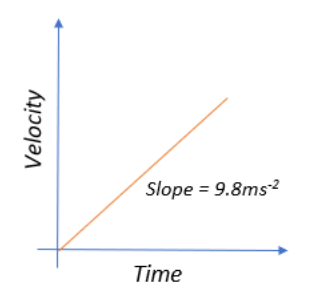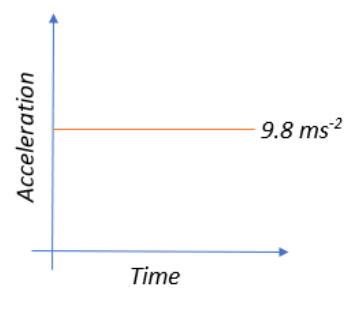
Acceleration-time graph of a freely falling body is:
A.)A straight line with positive slope
B.)A straight line with negative slope
C.)A straight line parallel to the time axis
D.)A straight line parallel to the acceleration axis
Answer
575.4k+ views
Hint: Think about the influencing forces for a body in a state of free fall. In other words, the only accelerative contribution is that of gravity. And the acceleration due to gravity when not subjected to any external forces remains the same throughout. So, in free fall, if the body is gaining velocity at a constant rate then think of what happens to the acceleration.
Complete answer:
Let us begin by understanding what a freely falling body is.
When a body is falling under the sole influence of gravity wherein it is being acted upon only by the force of gravity is called a freely falling body. There are two important notions that model free falling:
(I)The rate of change of velocity remains the same.
(II)All freely falling bodies on Earth accelerate at a rate of $9.8ms^{-2}$ downwards.
This means that a freely falling body undergoes a uniformly accelerated motion, which has the implication that acceleration remains constant throughout. This means that with time, the velocity increases at a constant rate.
If we were to look at the velocity-time graph, it would look something like:

Since the velocity is changing with time, it represents accelerated motion.
We get a diagonal with a constant slope of $9.8ms^{-2}$, which is indicative of constant uniform acceleration, since $acceleration = \dfrac{velocity}{time}$
In this case of constant acceleration where our acceleration does not change with time, we get the following graph:

Thus, from the above acceleration-time graph for a freely falling body we can conclude that the right option would be, A straight line parallel to the time axis.
So, the correct answer is “Option C”.
Note:
Remember that the acceleration remains constant for a freely falling body because it falls under the influence of only gravity. The velocity changes with time but at a constant rate throughout.
Complete answer:
Let us begin by understanding what a freely falling body is.
When a body is falling under the sole influence of gravity wherein it is being acted upon only by the force of gravity is called a freely falling body. There are two important notions that model free falling:
(I)The rate of change of velocity remains the same.
(II)All freely falling bodies on Earth accelerate at a rate of $9.8ms^{-2}$ downwards.
This means that a freely falling body undergoes a uniformly accelerated motion, which has the implication that acceleration remains constant throughout. This means that with time, the velocity increases at a constant rate.
If we were to look at the velocity-time graph, it would look something like:

Since the velocity is changing with time, it represents accelerated motion.
We get a diagonal with a constant slope of $9.8ms^{-2}$, which is indicative of constant uniform acceleration, since $acceleration = \dfrac{velocity}{time}$
In this case of constant acceleration where our acceleration does not change with time, we get the following graph:

Thus, from the above acceleration-time graph for a freely falling body we can conclude that the right option would be, A straight line parallel to the time axis.
So, the correct answer is “Option C”.
Note:
Remember that the acceleration remains constant for a freely falling body because it falls under the influence of only gravity. The velocity changes with time but at a constant rate throughout.
Recently Updated Pages
Master Class 12 Business Studies: Engaging Questions & Answers for Success

Master Class 12 Economics: Engaging Questions & Answers for Success

Master Class 12 English: Engaging Questions & Answers for Success

Master Class 12 Maths: Engaging Questions & Answers for Success

Master Class 12 Social Science: Engaging Questions & Answers for Success

Master Class 12 Chemistry: Engaging Questions & Answers for Success

Trending doubts
What is meant by exothermic and endothermic reactions class 11 chemistry CBSE

Which animal has three hearts class 11 biology CBSE

10 examples of friction in our daily life

One Metric ton is equal to kg A 10000 B 1000 C 100 class 11 physics CBSE

1 Quintal is equal to a 110 kg b 10 kg c 100kg d 1000 class 11 physics CBSE

Difference Between Prokaryotic Cells and Eukaryotic Cells




